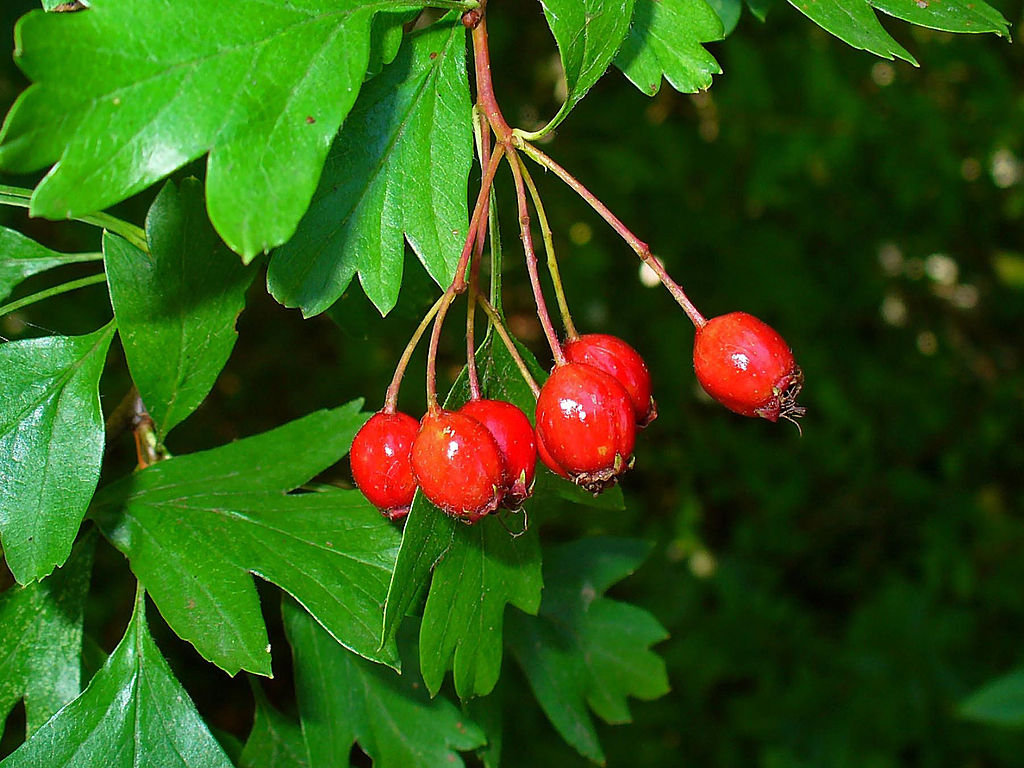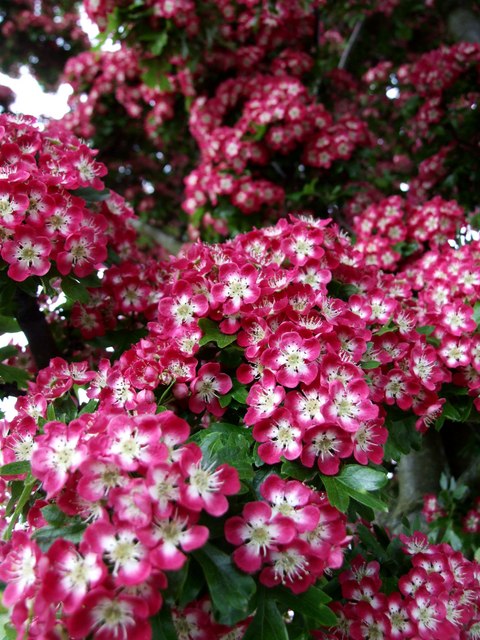Hawthorn Crataegus monogyna
Height in maturity up to 10 m
Flowering – blossom in May
Fruiting in late summer
Typical blossom Red variety of C. laevigata Fruit or haws
History and uses
Hawthorn has been well used throughout our history of countryside and garden, even by Culpeper’s time as he introduced his entry for hawthorn, ‘I do not mean to trouble my neighbour with the description of a tree so universally known to almost every inhabitant in this kingdom’.1. It was first formally recorded by William Turner in 1562.2. Hawthorn has many alternative names and much plantlore attached to it.3. Apart from the widely known alternative names such as quick-thorn, referring to its use as fast-growing hedge plant, and May for the month of its blossom, hawthorn has over 28 local names such as hag-thorn and hag-tree in Devon and Somerset, hipperty-haw tree in Shropshire, May-bush in Hampshire and Norfolk, quick-thorn in Lancashire and Yorkshire. There are a further 60 odd names for the haws, such as bird’s cherries and bird’s meat in Somerset, eggle-berry in Devon, wind-bibber in Kent. There’s a considerable amount of superstition surrounding hawthorn; many consider it unlucky to bring hawthorn blossom into the house, perhaps because it has a rather unpleasant smell of decay. However, there are also a few instances of it being a lucky plant such as in Ireland where it was said that the blossom of hawthorn brought into the home on May Day would keep evil away.
Culpeper recommends hawthorn as a remedy for the ‘stone and dropsy’ and recommended distilled water from the flowers applied to thorns and splinters, to ‘certainly draw them forth’.4. Medicinally hawthorn is said to have great healing effects including calming and reducing anxiety and improving blood circulation. It can be taken as a tea, hawthorn berry syrup or hawthorn tincture.5. As a food plant, hawthorn’s young leaves, sometimes called bread-and-cheese, can be gathered and added to salads.6. The haws may be used to flavour brandy in much the same way as sloes are used to flavour gin.
Associated species
Hawthorn's blossom in May – on the previous year’s growth – provides an excellent source of nectar for bees and hoverflies. In addition more than 200 species of herbivorous invertebrate are associated with hawthorn.7. These include beetles such as hawthorn leaf beetle Lochmaea crataegi, bugs, notably the hawthorn shield bug Acanthosoma haemorrhoidale, and flies including the attractive picture-winged fly in the Tephritidae, Anomoia purmunda. Around 125 species of moth are associated with hawthorn. These include the common and widespread orchard ermine Yponomeuta padella that also feeds on both blackthorn and other Prunus species, the feathered bright moth Incuvaria masculela, brimstone Opisthograptis luteolata and the swallow-tailed Ourapteryx sambucaria.
These insects, in addition to hawthorn’s buds and berries (haws) provide food for birds and small mammals such as hedgehogs, shrews and wood mice. As a tree or shrub, hawthorn offers good protective cover for nesting and roosting birds.
References
1. Culpeper’s Complete Herbal & English Physician. (1826). This edition published in 2003. Greenwich Editions. London p 71
2. Pearman, D. The Discovery of the Native Flora of Britain and Ireland. (2017). BSBI, Bristol p 166
3. Vickery, R. 2019. Vickery’s Folk Flora, An A to Z of the Folklore and Uses of British and Irish Plants. Weidenfeld & Nicolson. London pp 327-336
4. Culpeper’s Complete Herbal & English Physician. (1826). This edition published in 2003. Greenwich Editions. London p 71
5. Bruton-Seal J & Seal. M. (2008). Hedgerow Medicine. Merlin Unwin Books. Ludlow. p 64
6. Mabey, R. (1992) reprint. Food for Free. Collins, London. p 33
7. Biological Records Centre database
Page written by Caroline Ware, compiled by Steve Head
Hawthorn Crataegus monogyna
Family Rosaceae Rose family
Height in maturity up to 10 m
Flowering – blossom in May
Fruiting in late summer

_Crataegus_monogyna_-_Leaves_and_stipules.jpg)
_Crataegus_monogyna_-_flowers_and_buds.jpg)

Hawthorn is common throughout the British Isles and grows as a tree or shrub on woodland edges, in hedgerows and on windswept hillsides or marshes where it may be seen finely sculpted by the prevailing wind. As a pioneer species, hawthorn is one of the first shrub/tree species to appear in an area left to regenerate into woodland, forming thickets of scrub with bramble and blackthorn. It will also colonise urban waste ground.
Hawthorn is one of the easiest plants to grow as one of its alternative names, quickthorn, suggests and was used as boundaries for very early gardens. Once established it can be cut or pruned to any height. A row of hawthorn can be quickly trained into an impenetrable barrier, providing good nesting habitat for birds. Hawthorn, grows quickly whether planted with other hedge species, or as a single species hedge. It was the main hedging plant used for hedge boundaries, often in straight lines, during the field enclosures of the eighteenth and nineteenth centuries.
Planted in a garden, hawthorn will grow slowly into a small attractive tree and if space is confined, it may be coppiced or pruned and maintained as a small neat shrub, or grown with other species in a mixed hedge. Hawthorn can cope with most situations being tolerant of exposure, drought and water-logging. Midland hawthorn Crataegus laevigata is similar but slightly smaller and with fewer thorns and more roundly shaped leaves. Its fruit – haws – have two to three stones, compared to hawthorn’s one. There are garden cultivars of both species, some with dark pink blossom such as ‘Paul’s Scarlet’.


_Crataegus_monogyna_-_Leaves_and_stipules.jpg)
Hawthorn is common throughout the British Isles and grows as a tree or shrub on woodland edges, in hedgerows and on windswept hillsides or marshes where it may be seen finely sculpted by the prevailing wind. As a pioneer species, hawthorn is one of the first shrub/tree species to appear in an area left to regenerate into woodland, forming thickets of scrub with bramble and blackthorn. It will also colonise urban waste ground.
Hawthorn is one of the easiest plants to grow as one of its alternative names, quickthorn, suggests and was used as boundaries for very early gardens. Once established it can be cut or pruned to any height. A row of hawthorn can be quickly trained into an impenetrable barrier, providing good nesting habitat for birds. Hawthorn, grows quickly whether planted with other hedge species, or as a single species hedge. It was the main hedging plant used for hedge boundaries, often in straight lines, during the field enclosures of the eighteenth and nineteenth centuries.
Planted in a garden, hawthorn will grow slowly into a small attractive tree and if space is confined, it may be coppiced or pruned and maintained as a small neat shrub, or grown with other species in a mixed hedge. Hawthorn can cope with most situations being tolerant of exposure, drought and water-logging. Midland hawthorn Crataegus laevigata is similar but slightly smaller and with fewer thorns and more roundly shaped leaves. Its fruit – haws – have two to three stones, compared to hawthorn’s one. There are garden cultivars of both species, some with dark pink blossom such as ‘Paul’s Scarlet’.
_Crataegus_monogyna_-_flowers_and_buds.jpg)


Typical blossom Red variety of C. laevigata Fruit or haws
History and uses
Hawthorn has been well used throughout our history of countryside and garden, even by Culpeper’s time as he introduced his entry for hawthorn, ‘I do not mean to trouble my neighbour with the description of a tree so universally known to almost every inhabitant in this kingdom’.1. It was first formally recorded by William Turner in 1562.2. Hawthorn has many alternative names and much plantlore attached to it.3. Apart from the widely known alternative names such as quick-thorn, referring to its use as fast-growing hedge plant, and May for the month of its blossom, hawthorn has over 28 local names such as hag-thorn and hag-tree in Devon and Somerset, hipperty-haw tree in Shropshire, May-bush in Hampshire and Norfolk, quick-thorn in Lancashire and Yorkshire. There are a further 60 odd names for the haws, such as bird’s cherries and bird’s meat in Somerset, eggle-berry in Devon, wind-bibber in Kent. There’s a considerable amount of superstition surrounding hawthorn; many consider it unlucky to bring hawthorn blossom into the house, perhaps because it has a rather unpleasant smell of decay. However, there are also a few instances of it being a lucky plant such as in Ireland where it was said that the blossom of hawthorn brought into the home on May Day would keep evil away.
Culpeper recommends hawthorn as a remedy for the ‘stone and dropsy’ and recommended distilled water from the flowers applied to thorns and splinters, to ‘certainly draw them forth’.4. Medicinally hawthorn is said to have great healing effects including calming and reducing anxiety and improving blood circulation. It can be taken as a tea, hawthorn berry syrup or hawthorn tincture.5. As a food plant, hawthorn’s young leaves, sometimes called bread-and-cheese, can be gathered and added to salads.6. The haws may be used to flavour brandy in much the same way as sloes are used to flavour gin.
Associated species
Hawthorn's blossom in May – on the previous year’s growth – provides an excellent source of nectar for bees and hoverflies. In addition more than 200 species of herbivorous invertebrate are associated with hawthorn.7. These include beetles such as hawthorn leaf beetle Lochmaea crataegi, bugs, notably the hawthorn shield bug Acanthosoma haemorrhoidale, and flies including the attractive picture-winged fly in the Tephritidae, Anomoia purmunda. Around 125 species of moth are associated with hawthorn. These include the common and widespread orchard ermine Yponomeuta padella that also feeds on both blackthorn and other Prunus species, the feathered bright moth Incuvaria masculela, brimstone Opisthograptis luteolata and the swallow-tailed Ourapteryx sambucaria.
These insects, in addition to hawthorn’s buds and berries (haws) provide food for birds and small mammals such as hedgehogs, shrews and wood mice. As a tree or shrub, hawthorn offers good protective cover for nesting and roosting birds.
References
1. Culpeper’s Complete Herbal & English Physician. (1826). This edition published in 2003. Greenwich Editions. London p 71
2. Pearman, D. The Discovery of the Native Flora of Britain and Ireland. 2017. BSBI, Bristol p 166
3. Vickery, R. 2019. Vickery’s Folk Flora, An A to Z of the Folklore and Uses of British and Irish Plants. Weidenfeld & Nicolson. London pp 327-336
4. Culpeper’s Complete Herbal & English Physician. (1826). This edition published in 2003. Greenwich Editions. London p 71
5. Bruton-Seal J & Seal. M. (2008). Hedgerow Medicine. Merlin Unwin Books. Ludlow. p 64
6. Mabey, R. 1992 reprint. Food for Free. Collins, London. p 33
7. Biological Records Centre database
Page written by Caroline Ware, compiled by Steve Head
- Home
- Wild Plants
- Woody Plants
- Hedges
- Hawthorn







